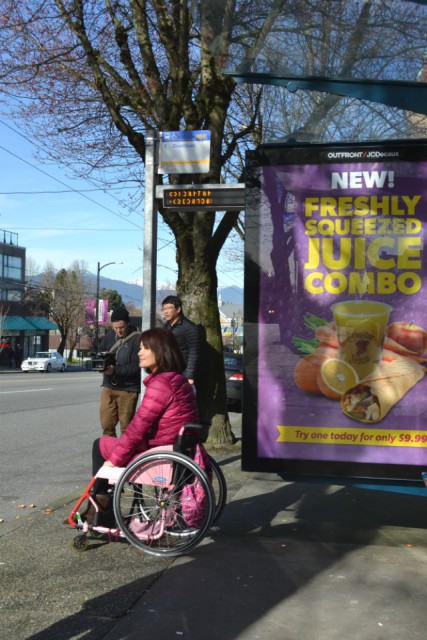My day with Mika: Understanding accessible transit
My day with Mika: Understanding accessible transit

This past spring I had the immense pleasure of tagging along on a filming request on our system and spent the afternoon with Kaz and Mika who wanted to showcase the accessibility of our system for a Japanese audience.
Kaz owns Motion Pla-net Productions that often produces work for NHK, Japan’s National public broadcasting organization.
Mika is a lovely woman who lives in downtown Vancouver and takes transit all the time in her fabulous pink wheelchair.
We spent the afternoon riding the bus and SkyTrain while Mika explained in Japanese to the camera all of the fittings and equipment TransLink offers on the system for those who need it.
Part of the filming also included speaking with TransLink’s Access Transit Coordinator, Sarah Chung about why TransLink has been so proactive in promoting the accessibility of transit services for people with disabilities.
“Public transit should be a safe and convenient way to travel, which means our infrastructure, policy and customer service are all impacted by accessibility. There are a number of different needs among our customers that we try to balance so we have to make sure the solutions we provide are sustainable and won’t hinder other people.
One of our key challenges is finding solutions that strike a balance between the diverse range of needs. We need to be financially responsible to the taxpayer as well, and have to prioritize our initiatives. Other challenges happen with the nature of the region, such as the geography making it difficult to make all bus stops wheelchair accessible.”
Mika says that the greatest strength of the system is that people with disabilities have choice.
“I know I can travel on bus, on SkyTrain, on the water on SeaBus and I will be able to get on there myself and be safe. Also being able to get to the airport without calling a taxi is great!”
I learned a lot travelling through the eyes of someone who faces accessibility challenges in her daily life.
On each part of our transit trip, I thought about space on buses, location of elevators, fare box heights, even something as simple as getting on and off a transit vehicle while others are trying to do the same.
These are things as an able-bodied person, I admit, I sometimes take for granted. Perhaps we all do. But it’s important to see through the eyes of others to really understand the world beyond ourselves.
As for the future, Sarah Chung says as an organization, TransLink is constantly growing and adapting our system to meet the needs of our customers.
“We are always looking at improvements to make the system as inclusive as possible. For example, we have a high percentage of wheelchair accessible bus stops, and have introduced a pilot project to make bus stops more accessible for people who are blind or partially sighted. The pilot includes tactile information panels and tactile walking surfaces to help people identify stop information and locations. As a region, we have recently transitioned to a contactless smart card payment system and are continue to work with partners to develop solutions for customers who have limited or no arm mobility.”
Have a look at some pictures from our day together.
Author: Adrienne Coling

















